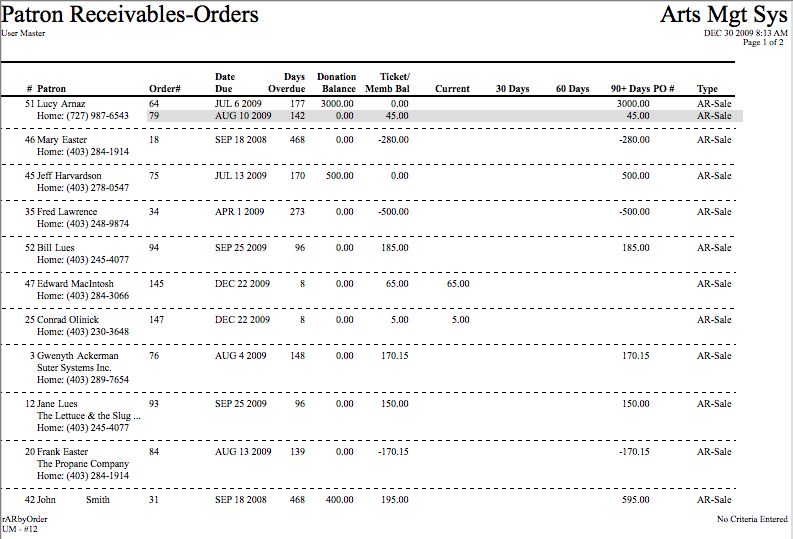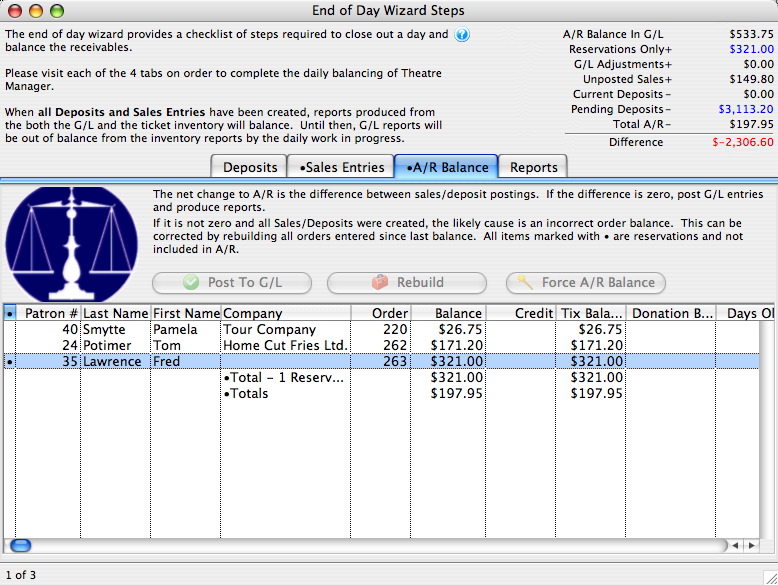Why is there only one A/R account in TM? Can we have one for donation receivables?
- uses pure accrual accounting -and-
- inventory management (eg tickets, donations, gift certificates) does not permit separate receivable accounts in any accounting system.
- The roots of double entry accounting and the early 15th century textbook by a franciscan monk Luca Pacioli, who documented the system used by the Venetians make interesting reading.
Corner Store Example
Here is a simple example of a transaction that might occur using a corner grocery store that illustrates the difficulty in the concept:
- Your partner sends you out to buy tomatoes, lettuce, cereal and you arrive at the checkout counter. The clerk scans everything through and indicates that you owe $100.00 for your groceries. Essentially, this increases the balance owing on the order.
- Then you dig through your wallet and find you have a visa card, some cash, and coupons for $1.00 off the box of cereal. You recall that you have not paid your visa bill yet and are unsure where the remaining limit is, so you give the coupon and as much cash as you have to the cashier. Then you pay the remaining $35.00 using your visa.
- Happy with your purchases, its off home only to find out that you were supposed to pick up some romaine lettuce instead of iceberg.
- back to the store to do an exchange of lettuce, but they are out of what you need, so you settle for arugula instead (after calling home to your partner to confirm)
- This costs more, but since have no more cash left, or limit on your visa, the clerk, who knows you well says Don't worry, pay the balance next time you are in!
The simple answer is that there is just one receivable. You still owe the grocer money for the balance on the order and it is really unclear, in an inventory management system, if that balance is for any particular item. To the grocer's accountant, the plain and simple answer is that you own them money. True, you could probably allocate part of the amount owing to tomatoes, cucumbers, lettuce or cereal, but as soon as you pay part of the payment next time you are in, you will alter each of those allocations - which is a lot of work and isn't something you want to do in any accrual based system.
Thats how all accounting/inventory management systems work, bar none. I do not know of one that separates out receivables on any inventory item. Yet we know that there is sometimes a need to get a good approximation for royalty purposes or renter chargebacks.
Using Tickets and Donations Instead
You can substitute tickets, subscriptions, donations, and gift certificates for any of the vegetables above and you will find that you cannot easily separate donations receivable, given the shear volume of transactions such as:
- exchanging tickets for donations
- paying for a subscription and an annual donation at the same time using post dated visa withdrawals
- entering that annual board gift as a receivable, only to be informed by the donor that the original (large amount) was to also include 2 subscriptions and the gala dinner
How to bend the rules
We know that venues like to try to identify receivables by inventory item, specifically donations. The A/R report for order shows an allocation of donation vs other receivables using the simple rule that donations are always paid for first before any other item in an order. This report provides backup to auditors at year end, or at any time you want to see the amount that could be considered to be in donation receivables.

- Who owes you the money
- The due date & days overdue. Very important: this can be affected by setting the final payment due date in the 'contractual' tab on the payment window. If it s a school/group sale for tickets, or an ad sales where they wont need to pay for 6 months, then set the final payment date 6 months in the future. If you do that, then the receivable will say in the current column - so this can be VERY useful)
- It makes a darn good guess at whether the receivable is for donations or tickets using simple criteria (see donation balance and ticket/memb balance columns). If there is a donation in the order, then any payment pays for that first before paying for tickets or anything else.
- It tells you current/30/60/90+ days overdue.. and based on that, who to send reminder notices to.
- And, if you wish, there is the PO# column. This comes form the payment window at the top of the screen (above the reason to buy). Normally nothing is put there, but you could put 'Ad Sale' or some other tag there if you want.
You can also see an amount in the End-of-Day wizard under the A/R tab. These are accurate at the instant they are viewed.

However (heavy emphasis on this), it is not wise to put this breakdown into your accounting program. Any simple ticket exchange for a donation, or conversion of a donation from a pledge to fully paid because the patron dropped off a check, or any turning in of a gift certificate for a donation simply becomes a make-work project and violates the rule of 'make G/L entries in your accounting program from TM's G/L list - exactly as is - unchanged'.
Since Theatre Manager handles it fine for you, it is not worth tracking in your accounting system. As illustrated above, the better way is to use TM as the A/R sub-ledger and produce sub-ledger reports from Theatre Manager.
In addition, you can move all future donations into a liability account using the setup in the donation fund accounts and be able to track future donations that way.